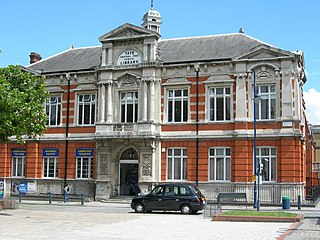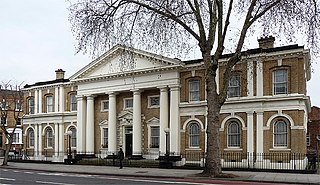
Brixton is a district in the south of London, England, within the London Borough of Lambeth. The area is identified in the London Plan as one of 35 major centres in Greater London. Brixton experienced a rapid rise in population during the 19th century as communications with central London improved.

Kennington is a district in south London, England. It is mainly within the London Borough of Lambeth, running along the boundary with the London Borough of Southwark, a boundary which can be discerned from the early medieval period between the Lambeth and St George's parishes of those boroughs respectively. It is located 1.4 miles (2.3 km) south of Charing Cross in Inner London and is identified as a local centre in the London Plan. It was a royal manor in the parish of St Mary, Lambeth in the county of Surrey and was the administrative centre of the parish from 1853. Proximity to central London was key to the development of the area as a residential suburb and it was incorporated into the metropolitan area of London in 1855.

Tulse Hill is a district in the London Borough of Lambeth in south London that sits on Brockwell Park. It is approximately five miles from Charing Cross and is bordered by Brixton, Dulwich, Herne Hill, Streatham, and West Norwood.

Lambeth was a civil parish and metropolitan borough in south London, England. It was an ancient parish in the county of Surrey. The parish was included in the area of responsibility of the Metropolitan Board of Works in 1855 and became part of the County of London in 1889. The parish of Lambeth became a metropolitan borough in 1900, following the London Government Act 1899, with the parish vestry replaced by a borough council.

Herne Hill is a district in South London, approximately four miles from Charing Cross and bordered by Brixton, Camberwell, Dulwich, and Tulse Hill. It sits to the north and east of Brockwell Park and straddles the boundary between the boroughs of Lambeth and Southwark. There is a road of the same name in the area, as well as a railway station.
The year 1972 in architecture involved some significant architectural events and new buildings.
The year 1932 in architecture involved some significant events.

Edward Blore was a 19th-century English landscape and architectural artist, architect and antiquary.

The Wellcome Library is founded on the collection formed by Sir Henry Wellcome (1853–1936), whose personal wealth allowed him to create one of the most ambitious collections of the 20th century. Henry Wellcome's interest was the history of medicine in a broad sense and included subjects such as alchemy or witchcraft, but also anthropology and ethnography. Since Henry Wellcome's death in 1936, the Wellcome Trust has been responsible for maintaining the Library's collection and funding its acquisitions. The library is free and open to the public.
The Twentieth Century Society (C20) is a British charity which campaigns for the preservation of architectural heritage from 1914 onwards. The society's interests embrace buildings and artefacts that characterise 20th-century Britain. It is formally recognised as one of the National Amenity Societies, and as such is a statutory consultee on alterations to listed buildings within its period of interest, and must be notified of any proposed work to a listed building which involves any element of demolition.

Henry Currey (1820–1900) was an English architect and surveyor.
George Topham Forrest, F.R.I.B.A. FGS FRSE was a Scottish architect who became chief architect for the London County Council and was responsible for the design of many public housing estates, and also co-designed two bridges over the River Thames.

The Roseate Reading Hotel is a boutique hotel in Reading, Berkshire, England. It is situated in the Forbury, formerly a part of Reading Abbey, and on the southern side of the modern Forbury Gardens. The building that forms the front section of the hotel was the Shire Hall for the County of Berkshire, built in 1911 and used as such until 1981, and is a grade II listed building.

George Finch was a British architect. He was a committed socialist who believed architecture had the power to transform the lives of post-war Londoners. Finch's ideals drove his passion for designing social housing, civic and environmental buildings for everyday people built to the highest building standards.
Bridget Cherry OBE, FSA, Hon. FRIBA is a British architectural historian who was series editor of the Pevsner Architectural Guides from 1971 until 2002. She is the co-author of several Pevsner guides.

Lambeth Town Hall, also known as Brixton Town Hall, is a municipal building at the corner of Brixton Hill and Acre Lane, Brixton, London. The town hall, which is the headquarters of Lambeth London Borough Council, is a Grade II listed building.

Central Hill is a social housing estate in the London Borough of Lambeth. It was designed by Rosemary Stjernstedt, Roger Westman and the Lambeth Council planning department during the directorship of Ted Hollamby. It comprises more than 450 homes built in 1966-74 near the site of the former Crystal Palace. Lambeth Council plans to demolish the estate so that it can build an extra 400 homes, many for private sale, so that it can finance the construction of new social housing.

The Brixton Library is a public library in the London Borough of Lambeth in Brixton, South West London. It was built in the 1890s by the sugar magnate Sir Henry Tate and is a Grade II listed building.

The Old Town Hall is a former municipal building in Kennington Road, Kennington, London, England. The town hall, which was briefly the headquarters of the Metropolitan Borough of Lambeth, is a Grade II listed building.














